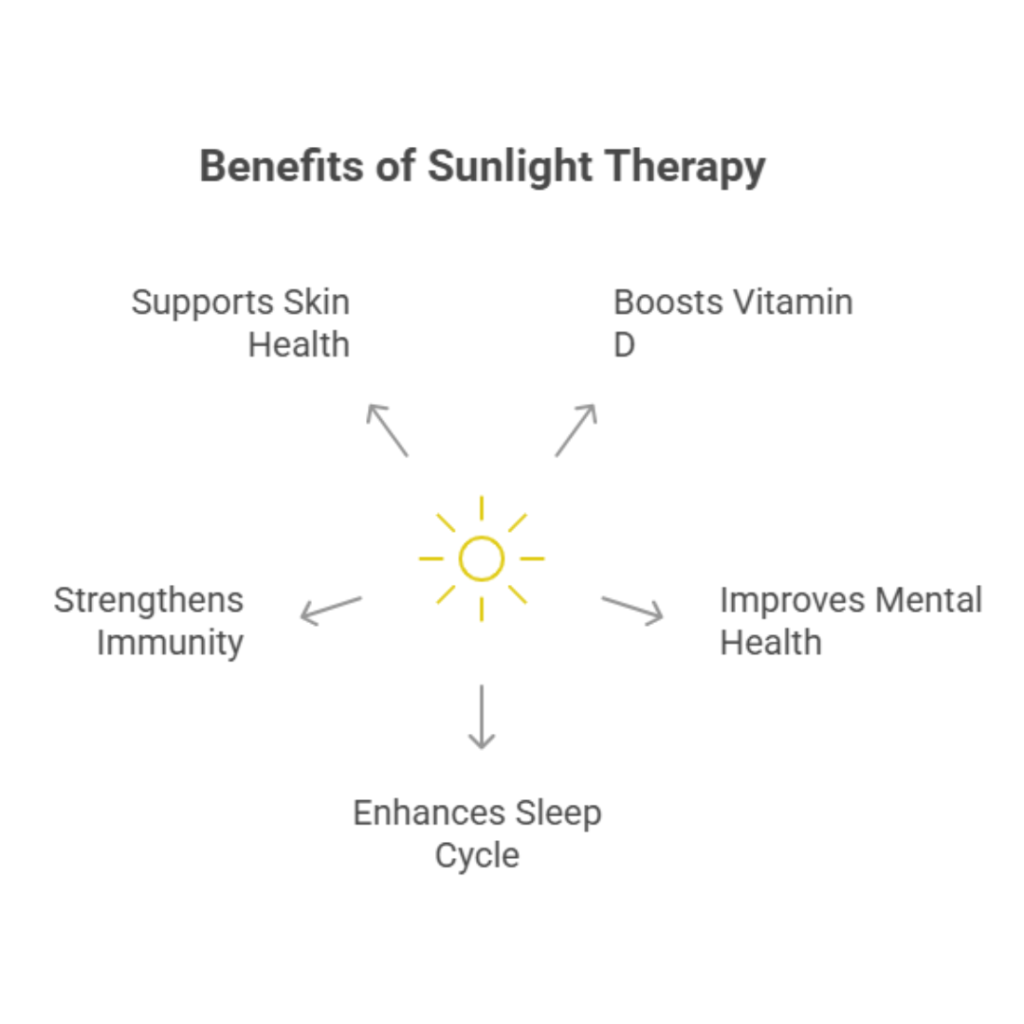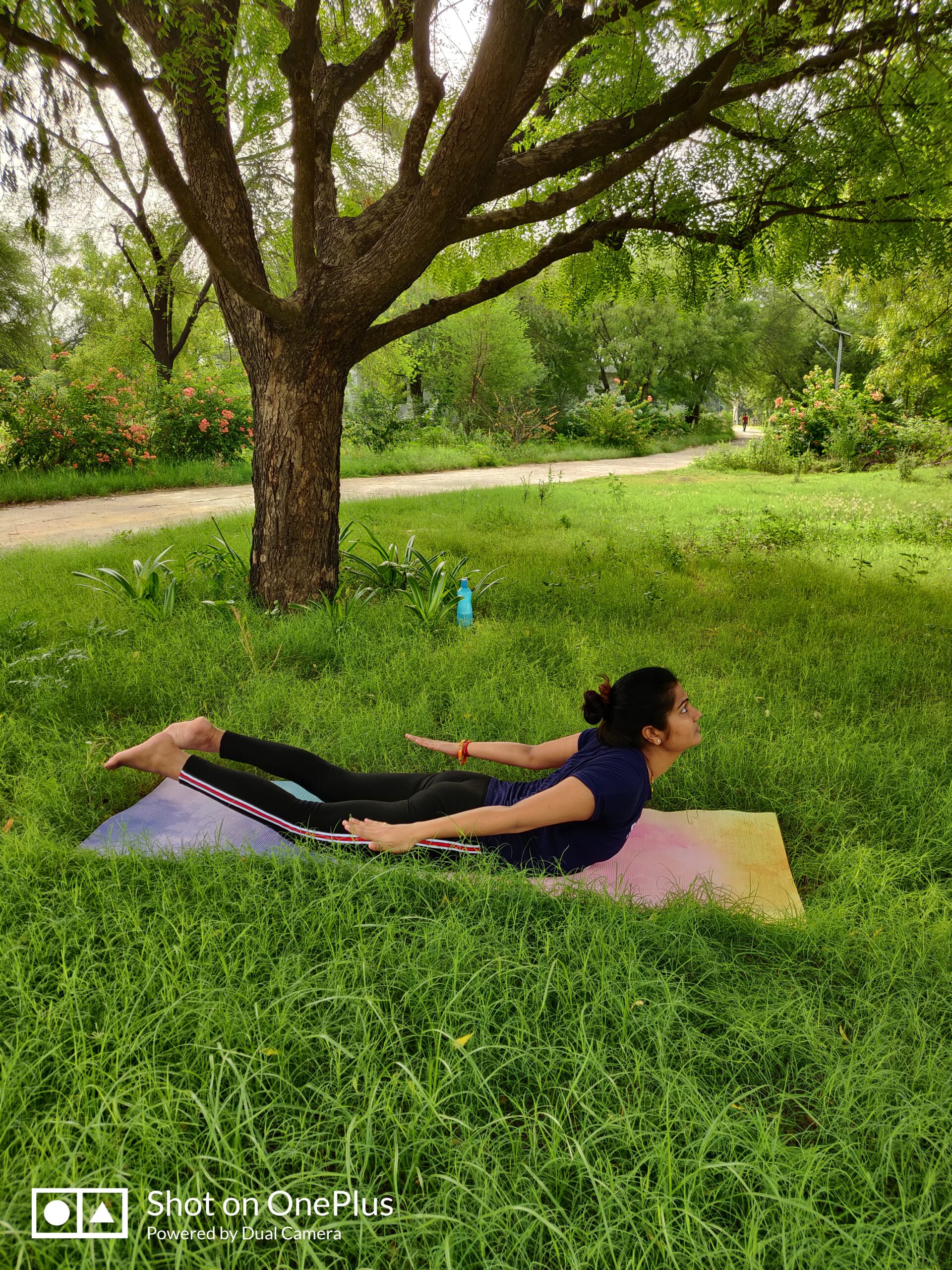Sunlight therapy—also known as heliotherapy or light therapy—is a natural wellness practice that involves controlled exposure to sunlight to promote physical and mental health. Rooted in ancient civilizations like Egypt and Greece, this therapy has been used for centuries to treat various ailments.
Today, with the rising interest in natural and holistic healing, sunlight therapy is making a strong comeback.
According to a Harvard study, moderate sunlight exposure helps the body produce vitamin D, essential for bone health and immune support.
At IDA Cure, Dr. Neha Patel recommends personalized sunlight therapy sessions as part of a comprehensive wellness plan, emphasizing its importance in today’s screen-dominated, indoor lifestyle.
Read More : Natural Ways to Improve Sleep: A Holistic Guide to Restful Nights
How Does Sunlight Therapy Work?
To understand the benefits of sunlight therapy, it’s important to explore how it actually works on a biological level. When our skin is exposed to the sun’s ultraviolet B (UVB) rays, it triggers the synthesis of vitamin D3—a crucial nutrient that supports bone health, immune function, and even hormone balance.
Scientific studies show that just 15–30 minutes of sun exposure a few times a week can significantly increase vitamin D levels in the body. This natural vitamin D production is far more efficient than relying solely on supplements.
But the benefits go beyond just vitamins. Light therapy taps into the body’s circadian rhythm—our internal clock that governs sleep, energy, and mood.
Certain wavelengths of sunlight, particularly in the blue and red light spectrum, can help regulate melatonin and serotonin production. These brain chemicals influence how alert or relaxed we feel.
At IDA Cure, Dr. Neha Patel often explains that consistent, safe sun exposure can lift mood and reduce symptoms of seasonal affective disorder (SAD), proving again how the benefits of sunlight therapy touch both body and mind.
What Are the Benefits of Sunlight Therapy?

Here’s a quick glance at the top benefits of sunlight therapy, supported by science and endorsed by wellness experts like Dr. Neha Patel at IDA Cure:
🌿 Boosts Vitamin D
Exposure to UVB rays helps the body naturally produce vitamin D, essential for calcium absorption and bone health.
😊 Improves Mental Health
Sunlight increases serotonin levels, which can uplift mood and reduce anxiety and depression symptoms—especially helpful in managing Seasonal Affective Disorder (SAD).
😴 Enhances Sleep Cycle
Natural light helps regulate your circadian rhythm, leading to better sleep patterns and overall energy levels.
🛡️ Strengthens Immunity
Adequate vitamin D from sunlight plays a vital role in keeping your immune system strong and responsive.
✨ Supports Skin Health
Controlled sunlight exposure may improve certain skin conditions like psoriasis, eczema, and acne when monitored by professionals.
Understanding these core benefits of sunlight therapy is the first step toward integrating it into a balanced wellness routine. At IDA Cure, Dr. Neha Patel offers customized light therapy plans to help individuals heal naturally and safely.
Vitamin D Synthesis & Bone Health
One of the most well-known benefits of sunlight therapy is its ability to stimulate natural vitamin D production in the body. When your skin is exposed to UVB rays, it converts cholesterol into vitamin D3, a vital hormone-like compound.
Vitamin D is crucial for calcium absorption, which directly impacts bone density and strength. Without enough vitamin D, even a calcium-rich diet may fall short in preventing bone-related disorders.
Low levels of vitamin D have been linked to osteoporosis, rickets, and increased risk of fractures, especially in older adults. A study published in the Journal of Bone and Mineral Research found that people with higher sun exposure had 20–30% lower risk of hip fractures.
At IDA Cure, Dr. Neha Patel emphasizes the importance of sunlight therapy in maintaining skeletal health, particularly for those at risk of vitamin D deficiency.
Safe, regular exposure under expert guidance can be a powerful natural tool for preventing chronic bone conditions—just one of the many benefits of sunlight therapy worth embracing.
Sunlight Therapy for Mental Health
Among the most profound benefits of sunlight therapy is its positive effect on mental health. Exposure to natural sunlight increases the brain’s release of serotonin, a hormone associated with boosting mood, focus, and overall emotional well-being.
According to the World Health Organization, more than 280 million people globally suffer from depression. Research published in The Lancet Psychiatry found that people exposed to higher levels of sunlight had significantly lower rates of depression and anxiety.
🌞 Sunlight therapy can help reduce symptoms of:
- Seasonal Affective Disorder (SAD) – a type of depression triggered by lack of sunlight, especially during winter months
- General depression and anxiety – by stabilizing circadian rhythms and increasing serotonin and melatonin production
At IDA Cure, Dr. Neha Patel integrates sunlight therapy into her holistic mental health programs. She has seen firsthand how clients experience reduced stress and improved mood after just a few weeks of consistent light exposure.
For anyone seeking natural mood enhancement, the benefits of sunlight therapy are not just effective—they’re transformative.
Read More : Can Nutrition Therapy Help Manage Stress and Anxiety?
Improves Sleep and Circadian Rhythm
One of the lesser-known yet powerful benefits of sunlight therapy is its impact on your body’s circadian rhythm—your internal 24-hour clock that controls sleep-wake cycles, hormone release, and metabolism.
Morning sunlight plays a critical role in melatonin regulation. While melatonin is known as the “sleep hormone,” its production is inhibited by light and triggered when it gets dark.
Exposure to natural sunlight during the day—especially in the morning—helps your brain set a healthy pattern for melatonin release at night, promoting deeper, more restful sleep.
Studies published in Sleep Health Journal show that people who get at least 20–30 minutes of morning sunlight report better sleep quality, faster sleep onset, and fewer disturbances during the night.
At IDA Cure, Dr. Neha Patel advises patients struggling with insomnia or irregular sleep patterns to include sunlight therapy in their daily routine. She explains that aligning your biological clock through natural light is one of the most sustainable and drug-free ways to improve sleep.
If you’ve been wondering how to reset your body naturally, this is where the benefits of sunlight therapy shine brightest.
Enhances Immune System Function
A strong immune system starts with proper nutrition—and that includes adequate levels of vitamin D, often called the “sunshine vitamin.” One of the essential benefits of sunlight therapy is that it helps your body produce this nutrient naturally through safe UVB exposure.
Vitamin D plays a critical role in immune regulation, activating T-cells that identify and destroy harmful pathogens. According to a 2020 study in Nutrients Journal, individuals with sufficient vitamin D levels are less likely to suffer from respiratory infections, including the common cold and flu.
✨ Sunlight therapy also contributes to:
- 🔥 Reduction in chronic inflammation, which is at the root of many lifestyle diseases
- 🚫 Lower risk of autoimmune conditions such as multiple sclerosis and rheumatoid arthritis, thanks to immune-balancing effects
At IDA Cure, Dr. Neha Patel integrates sunlight therapy into immune-boosting protocols, especially for clients prone to frequent infections or chronic inflammation. Her patients often experience better resilience against seasonal illnesses after consistent therapy sessions.
Supporting your body’s natural defense is just one more reason why the benefits of sunlight therapy go far beyond the surface.
Read More : Women’s Health Issues & Naturopathic Treatments
Skin Conditions That May Benefit
Many people are surprised to learn that one of the visible benefits of sunlight therapy is its positive effect on certain skin conditions—when practiced under safe, controlled exposure.
☀️ Conditions that sunlight therapy may improve:
- Psoriasis & Eczema – UVB light slows the rapid skin cell growth seen in psoriasis and reduces inflammation and itchiness in eczema.
- Acne – Mild sun exposure may help dry out excess oil and reduce the bacteria Propionibacterium acnes, which contributes to breakouts.
- Bacterial skin infections – UV light has mild antimicrobial properties that may help in healing superficial infections.
However, Dr. Neha Patel at IDA Cure strongly emphasizes the importance of safe sun exposure—limiting sessions to early morning or late afternoon hours, using protective measures like SPF for unaffected skin, and monitoring duration to prevent sunburn or UV damage.
Incorporating light therapy into a skincare regimen, under expert supervision, is a natural way to treat chronic issues. These skin-related improvements are yet another way the benefits of sunlight therapy prove both cosmetic and therapeutic.
Supports Heart & Metabolic Health
Another key area where the benefits of sunlight therapy shine is in improving cardiovascular and metabolic health. While often overlooked, sunlight plays a crucial role in supporting functions that regulate your heart and blood sugar levels.
☀️ Here’s how sunlight therapy helps:
- 💓 Lowers blood pressure – Research from the University of Edinburgh found that UVA rays stimulate nitric oxide release in the skin, which relaxes blood vessels and reduces blood pressure.
- 🧬 Improves cholesterol levels – Sunlight exposure can convert harmful LDL cholesterol into the vitamin D precursor, potentially improving lipid profiles over time.
- 🍽️ Enhances insulin sensitivity – Moderate UVB exposure has been linked to better glucose metabolism, helping reduce the risk of Type 2 diabetes.
At IDA Cure, Dr. Neha Patel integrates sunlight therapy into holistic plans for clients with high blood pressure, metabolic syndrome, or early signs of diabetes. Her approach combines safe light exposure with lifestyle and dietary guidance for optimal results.
When it comes to long-term wellness, the benefits of sunlight therapy go far beyond skin-deep—they reach the heart of your health.
Boosts Mood and Energy
One of the most instantly noticeable benefits of sunlight therapy is the way it uplifts your mood and boosts your energy levels—naturally and effectively.
Sunlight exposure triggers the brain to release dopamine and endorphins, the body’s natural “feel-good” chemicals that promote happiness and reduce stress.
✨ What sunlight therapy does:
- ⚡ Increases dopamine for improved motivation and mental clarity
- 😌 Triggers endorphins, reducing pain and promoting a sense of calm
- 💤 Reduces fatigue, especially in those who feel sluggish or tired despite adequate sleep
🌿 Real-life example:
A client at IDA Cure, a 32-year-old IT professional, reported chronic tiredness and mood swings. Under the guidance of Dr. Neha Patel, he began a 4-week sunlight therapy plan combined with lifestyle changes.
Within 10 days, he noticed improved focus, stable energy levels, and better emotional balance—a direct result of consistent early-morning light exposure.
Whether you’re battling burnout or just want a natural energy lift, the benefits of sunlight therapy offer a science-backed, side-effect-free solution to feeling your best every day.
Read More : What Relieves Symptoms of Depression?
Sunlight vs Artificial Light Therapy
While both sunlight and artificial light therapy aim to improve health and well-being, there are important differences between the two—especially when evaluating the true benefits of sunlight therapy.
☀️ Sunlight Therapy:
- Contains a full spectrum of light, including UVB rays necessary for vitamin D production
- Stimulates natural circadian rhythm alignment and mood regulation
- Is free and accessible, but dependent on weather and timing
💡 Artificial Light Therapy:
- Uses specially designed light boxes or lamps, typically emitting 10,000 lux of bright white light
- Lacks UV radiation, so it does not support vitamin D synthesis
- Ideal for those in low-light regions or winter seasons where sunlight is limited
💰 Cost Comparison:
Sunlight therapy is cost-free, while quality light boxes may range from ₹5,000 to ₹15,000 or more. However, they offer flexibility and consistency, especially for people with conditions like Seasonal Affective Disorder (SAD).
At IDA Cure, Dr. Neha Patel recommends natural sunlight whenever possible but may advise artificial light therapy during monsoons or for patients with limited outdoor access.
Still, she emphasizes that the benefits of sunlight therapy—especially for vitamin D, skin, and mood—are unmatched in their natural form.
Risks and Precautions of Sunlight Therapy
While the benefits of sunlight therapy are numerous, it’s important to understand that safe practice is key. Overexposure to UV radiation can lead to serious side effects that outweigh the potential health gains.
🔴 Risks of excessive sunlight exposure include:
- ☀️ Sunburn – especially for fair or sensitive skin types
- ⏳ Premature skin aging – due to prolonged UV damage
- 🎗️ Increased risk of skin cancer – particularly with unprotected, midday exposure over long periods
✅ Safe Sunlight Tips (based on skin type):
- Fair skin: Limit exposure to 10–15 mins in early morning or late afternoon
- Medium skin: 15–25 mins is typically safe with breaks
- Darker skin: May require 25–40 mins for vitamin D synthesis, but still avoid midday sun
When to consult a doctor:
If you have a history of skin conditions, autoimmune disorders, or take medications that cause photosensitivity, consult a professional before beginning any sunlight therapy. At IDA Cure, Dr. Neha Patel customizes therapy duration and timing based on individual skin tone, lifestyle, and medical history.
Remember, the benefits of sunlight therapy are best achieved through moderation, not overexposure.
Conclusion
From boosting vitamin D and improving mood to enhancing sleep and immunity, the benefits of sunlight therapy are holistic, science-backed, and accessible. When practiced safely and consistently, sunlight therapy can be a powerful natural remedy for both physical and mental well-being.
✅ You should consider sunlight therapy if you:
- Spend long hours indoors
- Struggle with fatigue, low mood, or poor sleep
- Have vitamin D deficiency or mild skin conditions
- Live in a region with regular sunlight exposure
However, sunlight therapy isn’t one-size-fits-all. Factors like skin type, location, and medical history must be considered. That’s why experts like Dr. Neha Patel at IDA Cure recommend seeking professional guidance before beginning a sunlight therapy routine.
If you’ve been wondering about natural ways to improve your health, it’s time to explore the many benefits of sunlight therapy—safely and wisely.
FAQs
Q1: Can I get enough Vitamin D from sunlight alone?
Yes—many people can meet their vitamin D needs through sunlight exposure, especially by getting 15–30 minutes of direct sunlight on the skin (without sunscreen) a few times a week. However, the amount varies based on your skin tone, location, and time of day.
At IDA Cure, Dr. Neha Patel often recommends lab testing to confirm vitamin D levels and determine if supplements are needed alongside therapy.
Q2: What if I live in a cloudy or winter-prone area?
In such regions, natural sunlight might not be sufficient year-round. While the benefits of sunlight therapy are ideal when sourced naturally, artificial light therapy (with medically approved light boxes) can help fill the gap—especially for mental health conditions like Seasonal Affective Disorder (SAD).
Dr. Neha Patel advises combining light therapy with nutrition and lifestyle changes for best results.
Q3: How does sunlight help with depression?
Sunlight stimulates the release of serotonin, a brain chemical that boosts mood and emotional stability. This is one of the major benefits of sunlight therapy, especially for people with depression, anxiety, or SAD.
Studies have shown that individuals who receive regular sunlight exposure report lower stress, better mood, and improved mental clarity.




